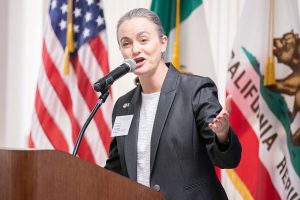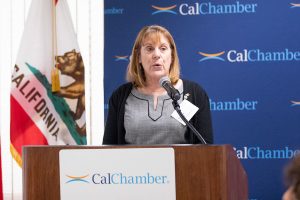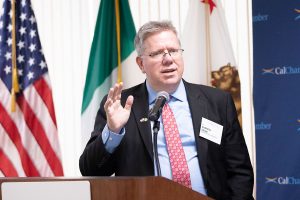 An international luncheon forum at the California Chamber of Commerce provided historical context and insights into the U.S. and California relationship with Mexico.
An international luncheon forum at the California Chamber of Commerce provided historical context and insights into the U.S. and California relationship with Mexico.
The Automobile Club of Southern California, a CalChamber member, was the luncheon sponsor.
The Consulate General of México, Sacramento, represented by Ambassador Liliana Ferrer, joined CalChamber in presenting the May 7 forum, attended by 100 guests.

CalChamber President and CEO Allan Zaremberg introduced the panelists providing the concise briefing:
• Dr. Pamela Starr, director of the U.S.-Mexico Network, University of Southern California, and senior advisor to Monarch Global Strategies. She spoke about the bilateral relationship with Mexico.
• Dr. Andrew Selee, president of the Migration Policy Institute, who spoke about economic interdependence and the U.S.-Mexico-Canada Agreement (USMCA).
• Dr. Rafael Fernández de Castro, director of the Center for U.S.-Mexican Studies, University of California, San Diego. He spoke about migration and border development.
Dr. Pamela Starr

Starr commented that the last quarter-century has been notable for the close bilateral collaboration between the U.S. and Mexican governments to work on common problems. The 1994 North American Free Trade Agreement (NAFTA) was adopted during that time.
The attitude of current Mexico President Andrés Manuel López Obrador is a throwback to the pre-1990 approach to U.S. Mexico relations, Starr commented.
President López Obrador is highly conscious of the power differential between Mexico and the United States, and his actions are governed by the philosophy that Mexico shouldn’t give the United States any excuse to interfere in Mexico internal affairs, she said.
The Mexico President is keeping focused on his domestic policy agenda and will not respond to provocations from President Donald Trump, said Dr. Starr.
That approach is not likely to change in the near future for three reasons, she said:
• The pending USMCA and the understanding that the Mexican economy depends on trade with the United States;
• Polls showing that the people of Mexico aren’t clamoring for their government to respond to President Trump’s remarks and do distinguish between the United States and the actions of the Trump administration; and
• President Trump’s apparent respect for President López Obrador, reflected in any critical comments being directed at Mexico in general and not President López Obrador personally.
The unlikelihood of any aggressive positive initiatives between the U.S. and Mexico governments, Dr. Starr said, leaves space for California to fill the void.
She commented that Mexico and California “produce things together through cross-border supply chains,” and the opportunity for engagement between California and Mexico is “enormous.”
Areas for collaboration she identified include dealing with organized crime and improving local law enforcement in Mexico, identifying best practices in drug enforcement.
Unlike his two predecessors as President, López Obrador is less interested in climate change and more focused on energy sovereignty for Mexico.
Individual states, however, are interested in reducing their carbon footprint, she said, providing an opening for California to reach out on wind, solar power and a potential energy water corridor—especially to the leaders of Baja California following the June election.
Dr. Andrew Selee

Dr. Selee sprinkled his remarks with examples from the book he published a year ago, Vanishing Frontiers: The Forces Driving Mexico and the United States Together.
One symbol of the integration of California and Mexico, he noted is the bridge between San Diego and Tijuana. That bridge turns the two cities into a single metropolitan area.
When the San Diego Airport was unable to expand, forcing innovative firms to drive to Los Angeles International Airport to find direct flights to Asia, the bridge to Tijuana provided a solution. San Diego-side residents could simply check in on the California side, then cross the bridge to Asia-bound international flights from Tijuana.
The bridge is a beautiful symbol of the “creative connection” between the United States and Mexico, he said, one “built around economic interdependence, which then leads to friendship” and people finding other ways to connect with each other.
The contribution of immigrants from Mexico is exemplified by the city of Hazleton, Pennsylvania, Dr. Selee said. Where storefronts on the main street in the city once were shuttered, there now is a vibrant business district. Many firms there are run by Dominican and Mexican immigrants.
Immigrants have rejuvenated the city, and large Mexican companies have a strong presence, having purchased the factory that produces 1 in every 4 pieces of fresh bread eaten in the nation—Bimbo Bakeries; Gruma owns the Mission brand tortilla plant outside the city—Americans now eat five times more tortillas than in the 1990s; and Mexican company Arca Continental owns the plant that makes Wise potato chips, the official potato chip of the New York Mets.
Similarly, investment by Mexico-based steel supplier DeAcero has revived Mid-Continent Nails, the nail factory in Poplar Bluff, Missouri. Just as auto and aerospace companies have integrated production across borders, the steel plant and the nail plant are integrating the making of nails in the United States, he said.
Dr. Selee expressed concern that disagreements about migration from south of the border will interfere with the ability of Mexico and the United States to “segment things” so that trouble in one area will “contaminate” the U.S.-Mexico trade relationship.
He commented that the number of Mexicans living in the United States dropped between 2010 and 2017, and that the latest huge influx of illegal immigrants is coming from Central America.
Dr. Selee called himself an “optimist” for the future of the U.S.-Mexico relationship. But, just as the pilot advises when an airplane hits turbulence, he said, “This is the moment to be fastening your seatbelts.”
Dr. Rafael Fernández de Castro

Dr. Fernández de Castro said California “has an enormous potential to become a wonderful Mexican ally.”
He cited examples of close personal relations between leaders from the United States and Mexico as keys to the relationship between the two nations.
The signing of the USMCA came about due to the excellence of Mexico’s negotiating team and commitment from both outgoing President Enrique Peña Nieto and incoming President López Obrador, Dr. de Castro said.
Dr. Fernández de Castro emphasized that for the future relationship between the United States and Mexico, it will be important for the two nations to do “something meaningful together” to address the migration of people from Central America and the Northern Triangle of Central America (Guatemala, Honduras and El Salvador).
How the two nations handle families will be a key, he said. Of the 100,000 people who came to the United States in March, 67% were women and children, he pointed out.
The United States and Mexico have to do “something meaningful together” and go to “the root of the problem, which is violence and poverty,” he said.
Staff Contact: Susanne T. Stirling

